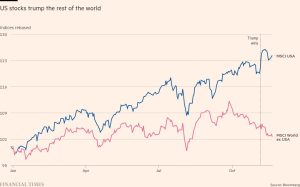Should you always ‘fill to the max’ on tax-free allowances?
On holiday in Sicily, we watched a demonstration of pizzu, how the Mafia took a wheat “tax” to pay for protection. A barrel of wheat was piled as high as it could go, with the pointed mound — or pizzu, Sicilian for “beak” — on top. A flat stick was then neatly scraped across the top of the barrel to remove the payment.
I instantly thought: that’s like what happens to our money if it’s not held in a tax wrapper.
I mentioned this to my family: and the pizzu taken could be much more than a beak-full of wheat because investments are potentially subject to capital gains tax on growth and income tax on dividends. The teenagers rolled their eyes, but I hope the message was absorbed all the same.
A friend got caught out when buying Tesla shares that rocketed during the pandemic. As he held them in a general investment account, not in an Isa or pension tax wrapper, he ended up paying a big CGT bill. His pizzu was 20 per cent of growth — only the £12,300 tax-free allowance softened the blow.
Since then, that allowance has been halved and halved again, while the dividend allowance has also been reduced twice. Lots of investors, my friend included, opened Isas as soon as they could — investment platforms reported a surge in “bed and Isa” activity at the end of the 2023 tax year, where investors transfer assets into the tax wrapper to protect future growth and dividends.
New government figures out this week show 12.5mn adult Isa accounts subscribed to that year, up from 11.8mn in the previous year — though the number of stocks and shares Isas decreased, perhaps due to cost of living concerns.
71%Rise in customers contributing the maximum £60,000 to their Sipps this year, according to Hargreaves Lansdown
Still, in anticipation of Labour’s “painful” Budget next month, investors are rushing to max out tax-free allowances in their Isa and pensions accounts, according to the UK’s largest platform Hargreaves Lansdown. It says that, so far this year, the number of customers contributing the maximum £60,000 to their self-invested personal pension, or Sipp, is up 71 per cent compared with a year earlier. Maximum contributions to stocks and shares Isas (£20,000) are up 31 per cent, while filling Junior Isa allowances (£9,000) is up 40 per cent.
According to Hargreaves Lansdown, investors are responding to the growing speculation that CGT rates could be aligned with income tax, which would result in gains being taxed as high as 45 per cent for the highest earners. If this happens, additional rate taxpayers could face a tax charge of £21,150 on a £50,000 capital gain made by an investment held outside a tax wrapper, according to Interactive Investor. This would be £11,750 more than the current tax liability under the existing CGT regime (£9,400). Nick Nesbitt, partner at financial advice firm Forvis Mazars, thinks savers are looking to maximise pension and Isa contributions in case these are reduced on October 30.
But is maxing out your allowances always the best strategy?
On the surface, stuffing tax-wrappers feels sensible — I still suspect too many investments have sat outside Isas for too long: the number of dividend taxpayers has doubled in the past three years (HMRC is expecting to collect £18bn in dividend tax this year).
But there are plenty of reasons why it may not be best to “fill to the max”.
For example, if you’re filling your pension allowance, that money is locked away, maybe for longer than you think, as the private pension age rises to 57. And if the state pension age goes up again or rises faster than already scheduled, the private pension age may rise in tandem.
You may also have more than you need in a pension or know that you’re going to have to pay a high level of tax to get it out in retirement. Therefore, it would be rational to favour other options such as Isas, gilts and other tax-efficient investments.
For example, someone with a £20,000 final salary pension (with a £60,000 lump sum at outset) and £1mn in their pension fund will have maxed out on their pension lump sum allowance. Also, with £20,000 of pension income plus £11,500 of state pension, they will have little scope to access their pension funds within the basic rate tax band. “People do often start to turn away from pension funding once they’ve got close to these limits,” says Nesbitt.
Another consideration is the timing of pension contributions to maximise the rate of income tax relief. The “carry forward facility” is the ability to use this year’s unused pension allowance next year. Some people may choose not to make contributions each year and instead concentrate more of their contribution potential into years where their earnings or tax liability is higher.
In the case of Junior Isas, advisers usually label anyone prioritising filling these over their own adult Isas as “crazy”. Lack of control of the money is the key issue — at 18 the child gets everything and has to manage the money by themselves. Nesbitt says an exception is clients who have sufficient pension provision but are keen to ensure they have a certain amount saved specifically for the children in their early adult lives (for expenditure such as weddings or house deposits).
Then there are cash Isas. In the first six months of the year, analysis by Paragon Bank found savers ploughed in an additional £42bn. At the end of June, there was £351.6bn held in adult cash Isas, compared with £309.3bn at the end of December 2023.
But if you have at least five years to lock away money, the advice is generally that it should go into a stocks and shares Isa, not into cash — unless you’re predicting a major stock market meltdown.
The interest rates on cash Isas have fallen since this time last year, too. According to Moneyfactscompare.co.uk, the top one-year fixed-rate savings account pays 5 per cent versus 4.67 per cent for the top one-year fixed cash Isa.
Advisers say that when there are better rates available on deposits and bonds than cash Isas, unless you’re a higher-rate taxpayer it may be rational to shun cash Isas.
The right strategy will depend on your individual tax rate, family circumstances and objectives. So, if you have the funds and are feeling the pressure to fill allowances before the Budget, be aware that there may be better ways to reduce your “pizzu”.
Moira O’Neill is a freelance money and investment writer. Email moira.o’[email protected], X: @MoiraONeill, Instagram @MoiraOnMoney
#fill #max #taxfree #allowances




